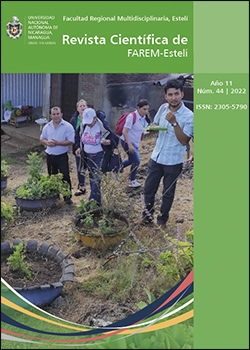The Internet as a means of transformation in the educational process in the communities of the Autonomous Region of the southern Caribbean Coast of Nicaragua
DOI:
https://doi.org/10.5377/farem.v11i44.15684Keywords:
Educational transformation, ICT and internet, digital gap, RACCSAbstract
Information and Communication Technologies (ICT) and the Internet are disruptive factors in educational systems; however, the digital divide prevents achieving the desired educational transformation. This research was carried out with the objective of exposing the digital gap in which the educational systems of communities with minimal or no access to these technologies coexist, due to their geographical location. It was conducted in 2 of the 12 municipalities of the South Caribbean Coast Autonomous Region (RACCS) of Nicaragua, the selected municipalities were Bluefields and Pearl Lagoon. The study was descriptive with a qualitative approach; the sample consisted of 180 trainees. The results made it possible to identify the state of the digital gap in the communities of the RACCS and clear indicators to reduce the digital gap of the educational system in these communities, giving clear guidelines of the challenge we face in the educational transformation through the Internet.
Downloads
References
Bermúdez-León, D. S., & Zúniga-Gonzalez, C. A. (2016). Las tecnologías de información y comunicación (TIC) como respuesta a necesidades educativas zonas rurales en Nicaragua. Rev. iberoam. bioecon. cambio clim., 2(4), 563-574. https://doi.org/10.5377/ribcc.v2i4.5931
Bernal, B., María, G., Ojeda, M., & Zanfrillo, A. (2010). BRECHA DIGITAL EN LA TRANSFERENCIA DE CONOCIMIENTOS: EDUCACIÓN SUPERIOR EN ARGENTINA Y MEXICO. redalyc, 3.
Caycedo Lozano, L., Trujillo Suárez, D. M., & García, S. S. (2016). La responsabilidad social, un componente esencial de la formación en un programa de química ambiental. Misión Jurídica, 9(10), 223-231. https://doi.org/10.25058/1794600x.127
Estrada Araoz, E. G., Mamani Roque, M., Gallegos Ramos, N. A., & Mamani Uchasara, H. J. (2020). Adicción a Internet y agresividad en estudiantes peruanos de educación secundaria. Apuntes Universitarios, 11(1), 140-157. https://doi.org/10.17162/au.v11i1.560
García Zaballos, A. (2012). Tecnologías de la información y la comunicación en Nicaragua. 30. https://publications.iadb.org/bitstream/handle/11319/5678/Tecnologías de la información y la comunicación en Nicaragua.pdf?sequence=1
INETER. (s. f.). DIVISIÓN POLÍTICA ADMINISTRATIVA DE NICARAGUA. Recuperado 3 de agosto de 2022, de https://www.ineter.gob.ni/ordt.html
INTUR. (2022). Región Autónoma de la Costa Caribe Sur - Mapa Nacional de Turismo. https://www.mapanicaragua.com/region-autonoma-de-la-costa-caribe-sur/
Lorduy, D. J., & Naranjo, C. P. (2020). Tecnologías de la información y la comunicación aplicadas a la educación en ciencias. Praxis & Saber, 11(27), e11177. https://doi.org/10.19053/22160159.v11.n27.2020.11177
Mañas Pérez, A., & Roig Vila, R. (2019). Las tecnologías de la información y la comunicación en el ámbito educativo. Un tándem necesario en el contexto de la sociedad actual. Revista Internacional d’Humanitats, 45, 75-86.
Mendoza, J. F., & Flores-Pacheco, J. A. (2021). Competencias digitales en la formación continua del profesorado, un estudio de caso para la Bluefields Indian & Caribbean University - BICU, Nicaragua. Revista Científica de FAREM-Estelí, 39, 157-169. https://doi.org/10.5377/farem.v10i39.12621
Navarrete, G., & Mendieta, R. (2018). Las Tic Y La Educación Ecuatoriana En Tiempos De Internet: Breve Análisis. Espirales, 2(15), 123-136. https://n9.cl/1xgzj
Regueyra, M. (2011). Aprendiendo con las TIC: una experiencia universitaria. Actualidades Investigativas en Educación, 11, 1-29. http://www.redalyc.org/articulo.oa?id=44718791008
Torres-Vargas, R., Calderón-Suárez, D., & Segobia-Ocaña, M. (2019). Impacto de las TIC en la enseñanza – aprendizaje de las ciencias experimentales en el bachillerato. Killkana Técnica, 3(2), 17-22. https://doi.org/10.26871/killkana_tecnica.v3i2.532
Published
How to Cite
Issue
Section
License
Copyright (c) 2023 Revista Científica de FAREM-Esteli

This work is licensed under a Creative Commons Attribution-NonCommercial-ShareAlike 4.0 International License.

